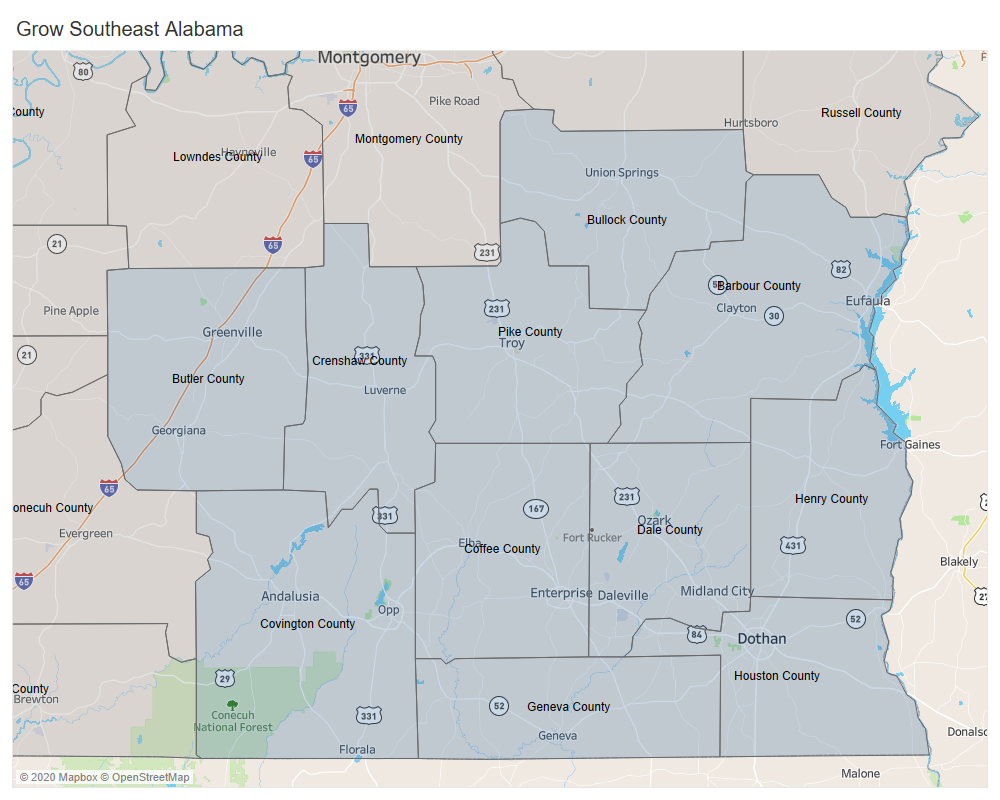Before the Coronavirus pandemic, economic developers in Southeast Alabama recognized the advantages of pulling together as a region rather than each city and county trying to recruit new industry independently. Wanting to take cooperation to a new level, they asked PARCA to investigate how other regional economic development organizations across the state and across the nation work.
When the pandemic struck, cooperation shifted into overdrive, and more counties rallied to the cause.
“We really pulled together as a region. We shared information about challenges and opportunities in the face of the crisis, and we strengthened our relationships,” said Veronica Crock, president of the Ozark-Dale County Economic Development Corporation. “As we come out of the pandemic, we will all benefit from working together to retain our existing businesses in a time of such uncertainty, and we will benefit from working together as a team to bring new jobs and industry to our region.”
PARCA’s newly released report, Growing Cooperation in Southeast Alabama, describes the efforts of the 11 counties in the state’s Wiregrass region to turn their loose alliance into a sustainable regional organization. Together, the counties hope to broaden their appeal, extend their reach, and amplify their message, while decreasing duplication of effort and expense.

Grow Southeast Alabama consists of economic development entities in Houston, Henry, Butler, Crenshaw, Coffee, Covington, Dale, Barbour, Bullock, Geneva, and Pike counties. Most off the Interstate corridors that connect the state’s largest metros, the counties in the Southeast corner of Alabama sometimes feel overlooked and undervalued. While known for peanut farming and pine forests, the region’s strength as a hub of aerospace and defense contractors is under-appreciated. Dothan, the region’s center of gravity, is the state’s seventh-largest city and is ringed by smaller but still considerable population centers, Enterprise and Ozark. Dothan is growing and serves as a trade and healthcare hub for a wide radius of counties in Alabama, Georgia, and Florida.
Though the counties are united under the state’s regional workforce council system, they are spread and don’t have a long history of working together. While that’s not uncommon, some portions of the state have a head start on building economic coordination and regional identity across county lines. For instance, North Alabama counties have been working together for decades through the North Alabama Industrial Development Association and the Alabama Mountain Lakes Tourist Association. There is no set pattern for how the various roles in economic development and workforce development are organized and carried out at the regional level. Sometimes a regional chamber of commerce, like the Birmingham Business Alliance or the West Alabama Chamber of Commerce, may play an overarching role. And meanwhile, a locally-funded economic development organization engages in more targeted recruitment and support for existing industries.
The developers involved in Grow Southeast are sorting out which functions will be carried out by a regional organization and which will remain local. A central challenge will be sustainably financing the regional organization while preserving funding for the local economic development organizations and programs. Another will be setting up rules and expectations for working together for the region while, at times, competing on behalf of their local community.
“We greatly enjoyed working with the PARCA team and are grateful for the professional, thorough, and detailed report they provided,” Crock said. “Their research was not only instrumental in bringing to light the positive and negative aspects of working collaboratively in a competitive environment, but also confirmed our commitment to putting this competitiveness aside for the sake of the region.”
“We benefitted from the research into the framework of successful economic development in other regions in the United States,” she said. “We will certainly rely on this report as we position ourselves to move forward in our regional collaboration effort.”
